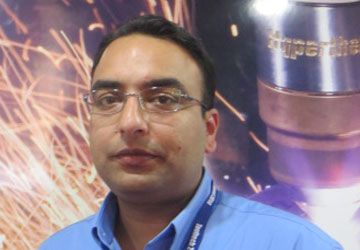Hypertherm’s journey in India…
2013 was a slow year, but we are hopeful that the market condition will improve once the new government is established and they start implementing measures to revive the economy. Oxyfuel continues to be the most widely adopted thermal cutting technology due to its low initial cost, but we will continue to introduce new products and solutions for our Indian customers.
How has metal cutting evolved over the years with the growing demand for higher speed and productivity?
As the demand for high productivity and speed increases, end-users are moving away from conventional and adopting automated technologies. Their expectations have increased drastically over the years. Today they want more consistent quality, higher productivity, efficiency, reliability and lower cost of manufacturing. This is also complemented by ‘Just In Time’ (JIT) manufacturing, so basically it calls for advanced metal cutting equipment.
And what’s the role of plasma cutting?
Plasma cutting meets most of the expectations mentioned above for end users and offers an optimised solution for metal cutting processes. There has been a lot of advancements in plasma cutting technology, offering solutions for a wider range of material types, thickness, and for a variety of industry segments.
How soon do you see this change happening in India?
More and more manufacturers are focusing on consistent quality and productivity. Partly, this is attributed to the global manufacturers setting base in India, which will drive growth in the demand of high-end technologies. India is moving toward adoption of modern manufacturing technologies, which will continue in the coming years.
What are the latest advancements in plasma cutting technology?
Systems are available now wherein minimum operator intervention is required for the job. For example, automated design to production systems, excellent cut quality on thin stainless steel, increased productivity, long consumable life (i.e. lower cost of cutting), improved hole quality are some of the recent trends in plasma cutting. All these can be achieved by an operator easily. One of Hypertherm’s philosophies is to constantly reduce the metal cutting costs yet with improved cut quality and productivity. As part of Hypertherm’s Built for Business – Integrated Cutting Solutions, some of the new technologies include HDi® thin stainless steel cutting, Rapid Part® technology for higher productivity, True Bevel® technology and the latest Powermax125 air plasma system with 100% duty cycle.
Laser and plasma have seen good response in India, but what about waterjet?
Adoption of Waterjet technology is picking up, there are certain areas where waterjet is quite applicable. If one wants to cut very thick materials or requires a zero heat affected zone, waterjet offers a good option for cutting metal. Also, waterjet can be used for non-metallic materials, which makes it a versatile cutting solution.
The automotive industry is in bad shape, which are the other emerging sectors to focus on during this period?
When we talk about plasma cutting, we will continue to focus on our core sectors. Our core sectors include those with high degree of plasma adoption, for example, construction equipment, infrastructure, railways, ship building, and even the agriculture industry, which is creating good demand for the technology. We offer solutions for all these segments, from simple hand cutting plasma systems to high end CNC plasma systems. In the automotive industry, they usually process on very thin metals so the usage of plasma is relatively low there. When we relate our industry performance, the above-mentioned sectors are our benchmarks. These industries are also looking to invest but unfortunately, 2013 was not that great a year. The Indian economy is also affected by global slowdown and this has put a hold on the investments which has affected everyone.
What are the challenges that the industry faces in terms of adopting latest automation solution in India, considering the fact that India is a price sensitive market?
The biggest challenge that the industry is facing right now is the current economic condition that has lowered investment amounts. Apart from this, I would say lack of awareness of the latest technologies, and lack of knowledge and exposure to the latest manufacturing technologies like plasma still exists in the Indian market.
There are reservations considering that the investments are associated with high end technology; however, the industry is adopting technologies wherever the investment justifies ROI (Return on investment).
What are present day customers looking for?
When we talk to customers, the first thing they want is cost effective solutions, and cost doesn’t always mean price; a solution which has multiple applications is a cost effective solution. They are looking at an increase in productivity, which means more automated product and lower operating costs. Apart from this, they also look for end-products with good cut quality, ease of use, and reliability. In addition to the technological aspect, good technical service support and after-sales service are also factors for consideration. System reliability is very important and customers are also looking for in-region service support.
India is home to several global players; what is your strategy to survive the competition?
Hypertherm focuses on research for continual innovation and to further develop the existing technologies. In addition, we have in-country sales and technical service associates to provide efficient support to customers. Also, with our ‘Cutting Technology Centre’, we continue to engage end users and train our channel partners to increase their service capabilities.
nishant@mfgtechupdate.com


